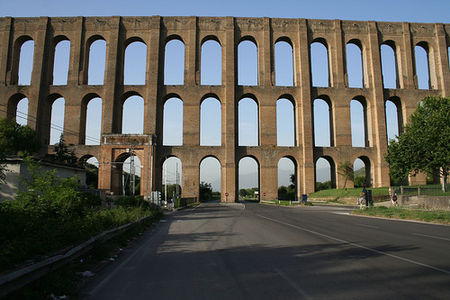Aqueduct of Vanvitelli

The Aqueduct of Vanvitelli or Caroline Aqueduct is a 38 km aqueduct that supplied water to the Reggia di Caserta and the San Leucio complex from the foot of the Taburno massif and springs of the Fizzo Contrada, in the territory of Bucciano. Mostly underground, the aqueduct is noted for its well-preserved, three-tier, 529-metre-long (1,736 ft) tufa-arched section bridging the Valle di Maddaloni between Monte Longano (to the east) and Monte Garzano (to the west). This section was modelled after Roman arched aqueducts, is 55.8 metres (183 ft) high at its highest point, crosses what is now highway SP335 — and was designated a World Heritage Site in 1997. Commissioned by Charles of Bourbon, the aqueduct was designed by and named after Luigi Vanvitelli. Construction began in March 1753 and it opened on 7 May 1762. It is located in SS265, 81020 Valle di Maddaloni CE, Italy.
Excerpt from the Wikipedia article Aqueduct of Vanvitelli (License: CC BY-SA 3.0, Authors, Images).Aqueduct of Vanvitelli
Strada Statale 265 Variante dei Ponti della Valle,
Geographical coordinates (GPS) Address Nearby Places Show on map
Geographical coordinates (GPS)
| Latitude | Longitude |
|---|---|
| N 41.059166666667 ° | E 14.401666666667 ° |
Address
Strada Statale 265 Variante dei Ponti della Valle
Strada Statale 265 Variante dei Ponti della Valle
81024
Campania, Italy
Open on Google Maps






